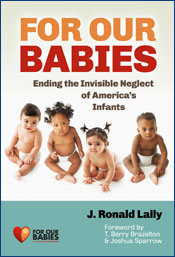A Call to Action on Behalf of U.S. Babies
Posted on

The facts are sobering. The United States is the only industrialized nation in the world without a paid-leave policy for parents at or around the birth of a child. Prenatal care in the United States remains expensive, while virtually all other industrialized countries provide free or affordable prenatal care. And, while families in the United States pay about 80 percent of the direct cost of childcare services, parents in European countries pay about 30 percent.
WestEd’s J. Ronald Lally says we can — and must — do better. With more than 45 years of experience developing programs and policies to improve the lives of infants, toddlers, and their families, Lally understands the urgency and necessity of supporting the healthy development of America’s next generation. The latest research in brain science confirms what Lally and other child development experts and practitioners have known for decades: A healthy, nurturing, and engaging first three years are critical to babies’ brain development, which supports their later success in school and life.
Problems that result from inadequate care of children ages zero to three are difficult, costly, and sometimes impossible to correct. Unfortunately, the United States has a long way to go to adequately nurture its young. It currently lags far behind virtually all other industrialized countries in the support it provides to infants, toddlers, and their families.
“American babies are getting inadequate prenatal care, less time at home with their parents during the first year of life, and fewer and lower-quality child care services, compared to babies in other industrialized countries,” says Lally, Co-Director of the Center for Child & Family Studies at WestEd. “The United States needs to become much more strategic and farsighted in the way it supports its children during their critical first few years of life.”
This reality is why Lally and his colleagues launched For Our Babies, a national initiative to promote healthy development in U.S. children from conception to age three. During this period of life, a baby’s brain undergoes an enormous transformation — growing from 25 to 85 percent of its adult size. The latest scientific research indicates that the actual physical structure of a baby’s brain, as well as its functioning, is significantly shaped by experiences and environments in the baby’s first three years.
Providing a “social womb” for early development
“For the first few years of life, the brain needs a ‘social womb,’” says Lally, “a safe, nurturing, and stimulating environment in which babies can learn how to interact with others and use the tools of society to get their needs met: ‘When I cry, somebody comes. When I communicate, somebody listens.’ That shapes the way babies function and relate to people for the rest of their lives.”
In advocating for a system that can foster this sort of “social womb,” the For Our Babies campaign takes a multi-pronged approach. It includes a compelling overview of the issues in Lally’s book, For Our Babies: Ending the Invisible Neglect of America’s Infants; a multimedia website (ForOurBabies.org); virtual and in-person public events; and strategic outreach to families, educators, the press, and policymakers. The initiative aims to spur local, grassroots action as well as national awareness and policy implementation.
For Our Babies builds upon decades of work by Lally and his WestEd colleagues, who have consistently been leaders in national efforts to improve infant/toddler care. In particular, WestEd, in collaboration with the California Department of Education, developed the Program for Infant/Toddler Care (PITC), a comprehensive training system that promotes responsive, relationship-based care. For more than two decades, PITC has been hugely influential in the field of early care: It is the most widely used training system for infant/toddler caregivers in the country, and its videos and print materials are distributed worldwide. PITC also worked with the U.S. Administration on Children, Youth, and Families to develop the Early Head Start program.
A call for comprehensive support
For Our Babies builds upon PITC’s theoretical and practical foundation by outlining a comprehensive platform of services and supports, focused around four pillars that track babies’ developmental trajectory from pre-conception to age three: prenatal care; paid leave; screening and follow-up services and well-baby care; and high-quality, affordable infant/toddler care.
Prenatal care
A common misconception is that development occurs only after children are born. In reality, the initial development of the fetus is shaped by its mother’s health even before she becomes pregnant. In recognition of this, many countries have instituted proactive public information campaigns. For instance, Lally notes that many European countries routinely alert women of child-bearing age to key health issues that could affect a future pregnancy, such as the importance of getting adequate amounts of folic acid to prevent spine and brain abnormalities in a fetus.
Much of the foundational wiring of a baby’s brain occurs prenatally, and several adverse factors — including a mother’s stress level, poor nutrition, or exposure to toxins — can affect the brain’s development at this stage. Thus, early and adequate prenatal care is vital to helping women assess and manage risk factors, in order to avoid stunting their children’s cognitive functioning. While virtually all other developed nations ensure free or affordable health care for pregnant women, care in the United States remains expensive, which limits the amount and quality of prenatal services that many women can access.
Paid leave
The United States currently has the dubious distinction of being the only industrialized country without a national paid-leave policy for parents at or around the birth of a child. This deficit is worrisome since paid leave enables an important period of bonding between parents and their newborns during a phase when babies’ brains are highly receptive to the care and communication they experience. Studies have shown that paid parental leave gives mothers important time to recover from childbirth and adapt to motherhood and that it improves the likelihood that mothers will remain in the workforce and achieve higher earning potential. Research also indicates that paid family leave significantly increases the length of time that mothers nurse, which can have important health benefits for infants.
Currently, the federal Family and Medical Leave Act grants 12 weeks of unpaid time off for parents to care for a newborn child. However, due to its eligibility criteria, only a small percentage of American mothers and fathers qualify, and very few states offer any form of paid family leave, making it inaccessible to many Americans. A 2011 survey by the U.S. Department of Labor revealed that only 11 percent of private-sector workers and 17 percent of public-sector workers reported having access to paid family leave through their employers.
Screening and follow-up services
Early and regular health screening and well-baby care can help identify and mitigate effects of a variety of potential health issues, including cerebral palsy, sensory and motor disabilities, respiratory illnesses, and learning and behavioral disorders. Attending to these issues from the start of life is critical, says Lally, because later attempts to correct early developmental problems are often more costly and less effective.
Accordingly, many countries provide a variety of preventative maternal and health care and guidance. For instance, among other well-baby services, the Australian state of Victoria provides a series of home visits to all mothers, regardless of income, until a baby is two years old. “Victoria’s system is quite forward looking,” says Lally. “Like many other localities and countries around the world, they have created a system to provide these vital well-baby care services without differentiating between rich and poor — because all children and families need these supports.”
High-quality, affordable infant/toddler care
High-quality early care has been shown to increase school readiness, improve math and language ability, help reduce the incidence of cognitive and social difficulties, and decrease the likelihood of a child repeating a grade or being placed in special education. Because a large portion of American infants and toddlers spend at least part of each week in out-of-home care settings, access to affordable and effective infant/toddler care is particularly critical.
Unfortunately, the average cost of daycare in the United States is beyond the means of many families. European families typically pay about 30 percent of the direct cost of child care services (with the rest subsidized through various sources), while American families typically pay a staggering 80 percent of direct child care costs. Despite the exorbitant costs, however, many daycare settings in the United States fall below universally accepted health and safety standards, and much of the care provided in these settings does not adequately nurture babies’ brain development.
Ultimately, Lally says, the reasons to invest in our nation’s babies are far more profound than a list of economic pros and cons. “A few years ago, my colleague was visiting France to look at their system of infant/toddler care services, which is largely publicly financed,” remembers Lally. “She asked one of the French politicians how France could afford to offer all of these services. The politician looked surprised by her question and said, ‘These are our children. They’re our country’s future — how could we afford not to provide these services?’”
This article was first published in WestEd’s R&D Alert, Vol. 14, No.3, 2014.

